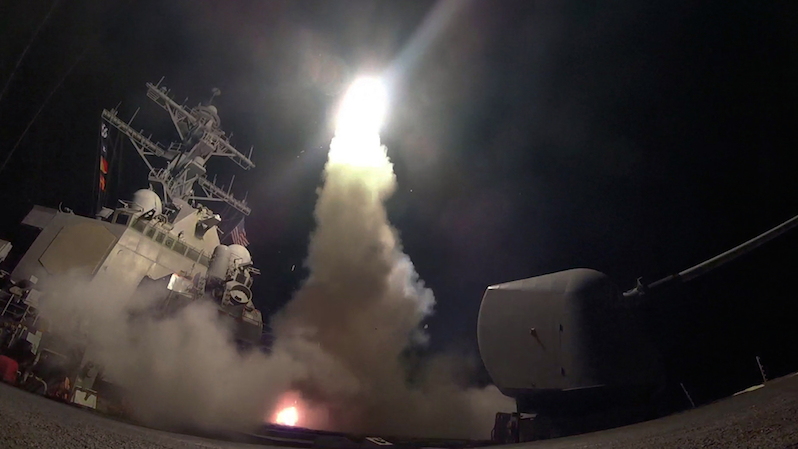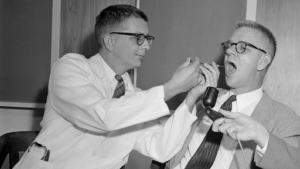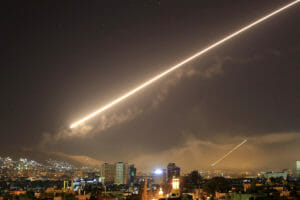Dereliction of Duty, Redux
All the evidence in Syria leads to an inescapable conclusion: The American military strike was a violation of international law. The guided-missile destroyer USS Porter launches a Tomahawk land attack missile aimed at Shayrat air base in Syria on April 6. (Mass Communication Specialist 3rd Class Ford Williams / U.S. Navy via AP)
1
2
3
4
The guided-missile destroyer USS Porter launches a Tomahawk land attack missile aimed at Shayrat air base in Syria on April 6. (Mass Communication Specialist 3rd Class Ford Williams / U.S. Navy via AP)
1
2
3
4
The situation vis-a-vis international law is murkier. Chapter VII of the United Nations Charter (which, having been duly ratified by the U.S. Senate as a treaty, became the “supreme law of the land” in this country) holds that the Security Council is the sole arbiter with regard to determining the existence of any threat to the peace, breach of peace, or act of aggression, and as such is uniquely empowered with the right to authorize the use of force, under Article 42 of Chapter VII.
The U.S. did call for an emergency meeting of the Security Council prior to Trump’s order for the attack on Syria. However, no resolution was passed under Chapter VII that authorized the use of military force. The U.S. ambassador to the U.N., Nikki Haley, put the members of the Security Council on notice, declaring, “[I]n the life of the United Nations, there are times when we are compelled to do more than just talk. There are times we are compelled to take collective action. This Security Council thinks of itself as a defender of peace, security, and human rights. We will not deserve that description if we do not rise to action today.”
Haley chastised Russia, which as a permanent member wields a veto that could prevent any Chapter VII authorization of force against Syria, noting that “[j]ust a few weeks ago, this Council attempted to hold Assad accountable for suffocating his own people to death with toxic chemicals. Russia stood in the way of this accountability.” Haley was referring to a February 2017 resolution condemning Syria for allegations it used chlorine weapons against rebel forces on three occasions between 2014 and 2015. The findings were based on a report by the U.N. Joint Investigative Mechanism (JIM) that was challenged by the Russians, who criticized the JIM’s repeated citation of nonscientific, highly politicized sources closely affiliated with the rebel forces. Russia viewed the resolution as a political exercise, and, together with China, vetoed it.
Given the gravity of the situation in Khan Shaykhun, as conveyed by Haley, similar inaction was not an option. “The question members of this Council must ask themselves,” Haley declared, “is this: If we are not able to enforce resolutions preventing the use of chemical weapons, what does that say for our chances of ending the broader conflict in Syria? If we are not able to enforce resolutions preventing the use of chemical weapons, what does that say about our effectiveness in this institution?”
Haley answered her own question: “When the United Nations consistently fails in its duty to act collectively, there are times in the life of states that we are compelled to take our own action.”
There is no authority under the U.N. Charter for nations to undertake unilateral military action. Indeed, the very purpose of the United Nations as an organization is to prevent unilateralism in all its forms, especially armed aggression. Strictly speaking, void of any Chapter VII authorization, the U.S. cruise missile attack on Syria represents a de facto violation of international law. Both the president’s speech on April 6 and Haley’s address to the Security Council presented any American intervention in Syria in response to a chemical weapons attack as a mandatory duty under international law.
No nation is required under international law to forego its right to self-defense. Article 51 of Chapter VII goes further, speaking of “the inherent right of individual or collective self-defense if an armed attack against a Member of the United Nations occurs.” Syria did not attack either the United States or American personnel and property. However, a case could be made for “collective self-defense” under Article 51 if the U.S. was formally aligned with those who were attacked, or if the people who were attacked were afforded status as “members of the United Nations.”
While no formal effort had been undertaken by anyone to revoke the credentials of the Assad government as the legitimate representative of Syria in the United Nations, 17 U.N. members, including three of the five permanent members of the Security Council (the U.S., Great Britain and France) have recognized an umbrella rebel organization, the Syrian National Council (SNC), as the legitimate representative of the Syrian people. It should be noted that the rebel group Tahrir al-Sham (formerly known as Al Nusra, or al-Qaida in Syria), which controls the region surrounding Khan Shaykhun, is not a member of the SNC, and indeed is engaged in active combat against forces loyal to the SNC.
The crux of any case in favor of the cruise missile attack on Syria hinges on the issue of chemical weapons. Syria joined the CWC in September 2013, following a chemical weapons incident in the Damascus suburb of Ghouta that allegedly killed 1,400 civilians (although this number is in dispute). As was the case in Khan Shaykhun, rebel forces, backed by the U.S. and Europe, attributed the attack to the Syrian government. The Syrian government blamed the rebels. Then-President Barack Obama threatened military action in response, but aborted the attack when evidence pinning the attack on the Syrian government proved to be less than conclusive. At the behest of Russia, the U.S. agreed to forestall a military attack in exchange for Syria’s accession to the CWC and its agreement to dispose of all its chemical weapons stocks and related facilities and equipment.
Importantly, the disarmament of Syria’s chemical weapons under the supervision of the Organization for the Prohibition of Chemical Weapons (OPCW) was codified in a Security Council resolution, 2118 (2013), that “[d]ecides, in the event of non-compliance with this resolution, including unauthorized transfer of chemical weapons, or any use of chemical weapons by anyone in the Syrian Arab Republic, to impose measures under Chapter VII of the United Nations Charter.” This language was insisted on by the Russians, who wanted the Security Council to have to meet and pass a new resolution authorizing Chapter VII measures, such as military action, to prevent just the sort of unsanctioned action the U.S. undertook against Shayrat air base on April 6.
To overcome any objection to the U.S. attack that might be raised on the grounds of international law, the U.S. would need to prove that Syria was in violation of Security Council resolution 2118 (2013), that this violation represented an ongoing threat to peace, and that, given Russia’s record of support for the Syrian regime, there was no chance of the Security Council enacting the kind of Chapter VII enforcement required by resolution 2118. The critical aspect of such a case is, therefore, the intelligence used by the U.S. to underpin its contention that Syria used chemicals weapons against Khan Shaykhun on the morning of April 4.
The Trump administration has yet to provide specifics of the intelligence it relied on to support the allegations levied against Syria. The Pentagon eventually produced what it claimed to be a radar track of a Syrian aircraft, believed to be an SU-22 fighter bomber, that took off from Shayrat airbase and was over Khan Shaykhun at the time of the alleged chemical attack. This radar track was produced in conjunction with what McMaster called “our friends and partners and allies around the world”, but most likely derived from a NATO AWACS reconnaissance aircraft flying over Turkey at the time. According to other U.S. military sources, the same system used to track the SU-22 aircraft also detected the release of weapons, and the impact of these weapons on the ground, using infrared (IR) sensors that detected the heat signatures associated with both events.
According to McMaster, the intelligence linking this documented airstrike to the chemical incident in Khan Shaykhun was drawn exclusively from images released by rebel-affiliated media activists, including the “White Helmets,” and from media reports about observed symptoms by medical personnel who claimed contact with the victims. At this point, there is no evidence the U.S. intelligence community used any independent information to corroborate the reports out of Syria. Instead, a combination of images and alleged eyewitness accounts from persons under the exclusive control of Tahrir al-Sham and medical evaluation of persons presented to medical authorities by Tahrir al-Sham “confirmed” the use of a nerve agent.
Curiously, McMaster also alluded to the existence of unspecified intelligence information that allowed the U.S. to designate specific areas within the Shayrat air base that were used to store the sarin nerve agent, noting that these areas were deliberately not targeted to avoid an inadvertent release of chemical agents and harm to nearby civilian communities.
Your support matters…
SUPPORT TRUTHDIG
Independent journalism is under threat and overshadowed by heavily funded mainstream media.
You can help level the playing field. Become a member.
Your tax-deductible contribution keeps us digging beneath the headlines to give you thought-provoking, investigative reporting and analysis that unearths what's really happening- without compromise.
Give today to support our courageous, independent journalists.





You need to be a supporter to comment.
There are currently no responses to this article.
Be the first to respond.